Supporting Diversity and Equity in Education
VerifiedAdded on 2022/11/25
|12
|3777
|286
AI Summary
This document discusses the challenges and strengths of supporting diverse and equitable learning environments in education. It explores strategies for partnering with families of children with hearing loss to develop inclusive provisions. The document also highlights the importance of language and speech skills in students with hearing impairments. It includes three journal articles on digital transformation, virtual learning environments, and the transition from early intervention to school. Overall, it provides insights and resources for supporting diversity and equity in education.
Contribute Materials
Your contribution can guide someone’s learning journey. Share your
documents today.
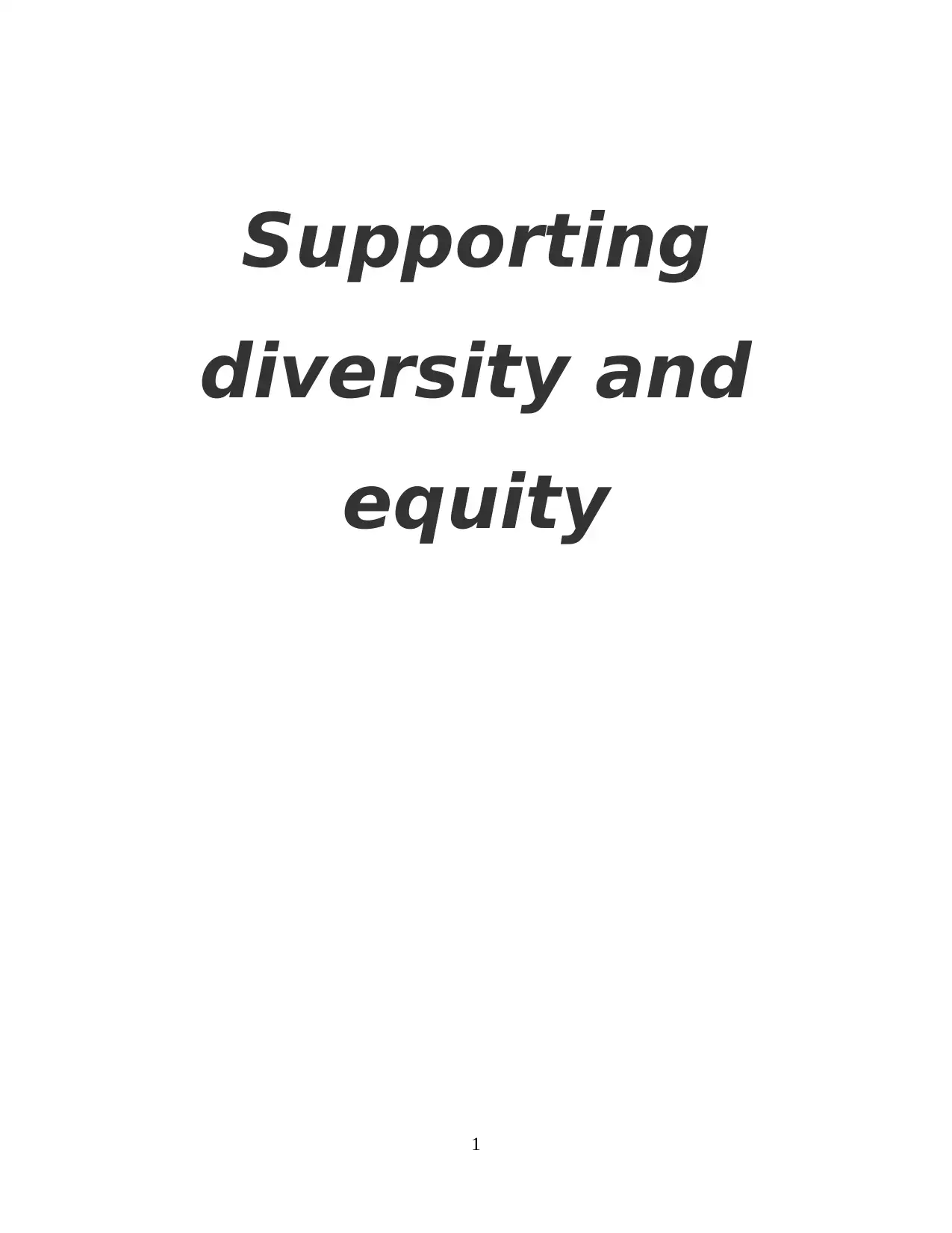
Supporting
diversity and
equity
1
diversity and
equity
1
Secure Best Marks with AI Grader
Need help grading? Try our AI Grader for instant feedback on your assignments.
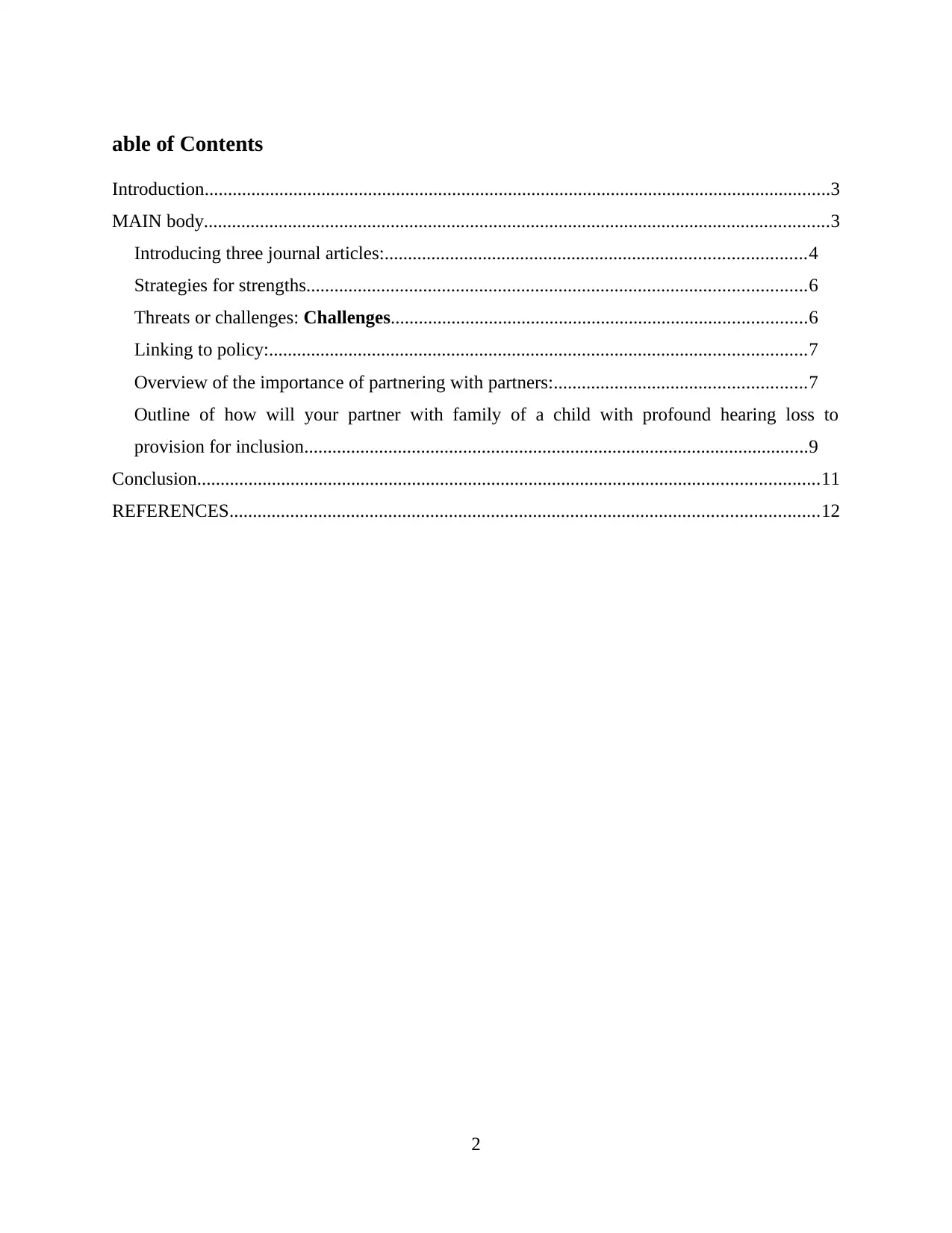
able of Contents
Introduction......................................................................................................................................3
MAIN body......................................................................................................................................3
Introducing three journal articles:..........................................................................................4
Strategies for strengths...........................................................................................................6
Threats or challenges: Challenges.........................................................................................6
Linking to policy:...................................................................................................................7
Overview of the importance of partnering with partners:......................................................7
Outline of how will your partner with family of a child with profound hearing loss to
provision for inclusion............................................................................................................9
Conclusion.....................................................................................................................................11
REFERENCES..............................................................................................................................12
2
Introduction......................................................................................................................................3
MAIN body......................................................................................................................................3
Introducing three journal articles:..........................................................................................4
Strategies for strengths...........................................................................................................6
Threats or challenges: Challenges.........................................................................................6
Linking to policy:...................................................................................................................7
Overview of the importance of partnering with partners:......................................................7
Outline of how will your partner with family of a child with profound hearing loss to
provision for inclusion............................................................................................................9
Conclusion.....................................................................................................................................11
REFERENCES..............................................................................................................................12
2
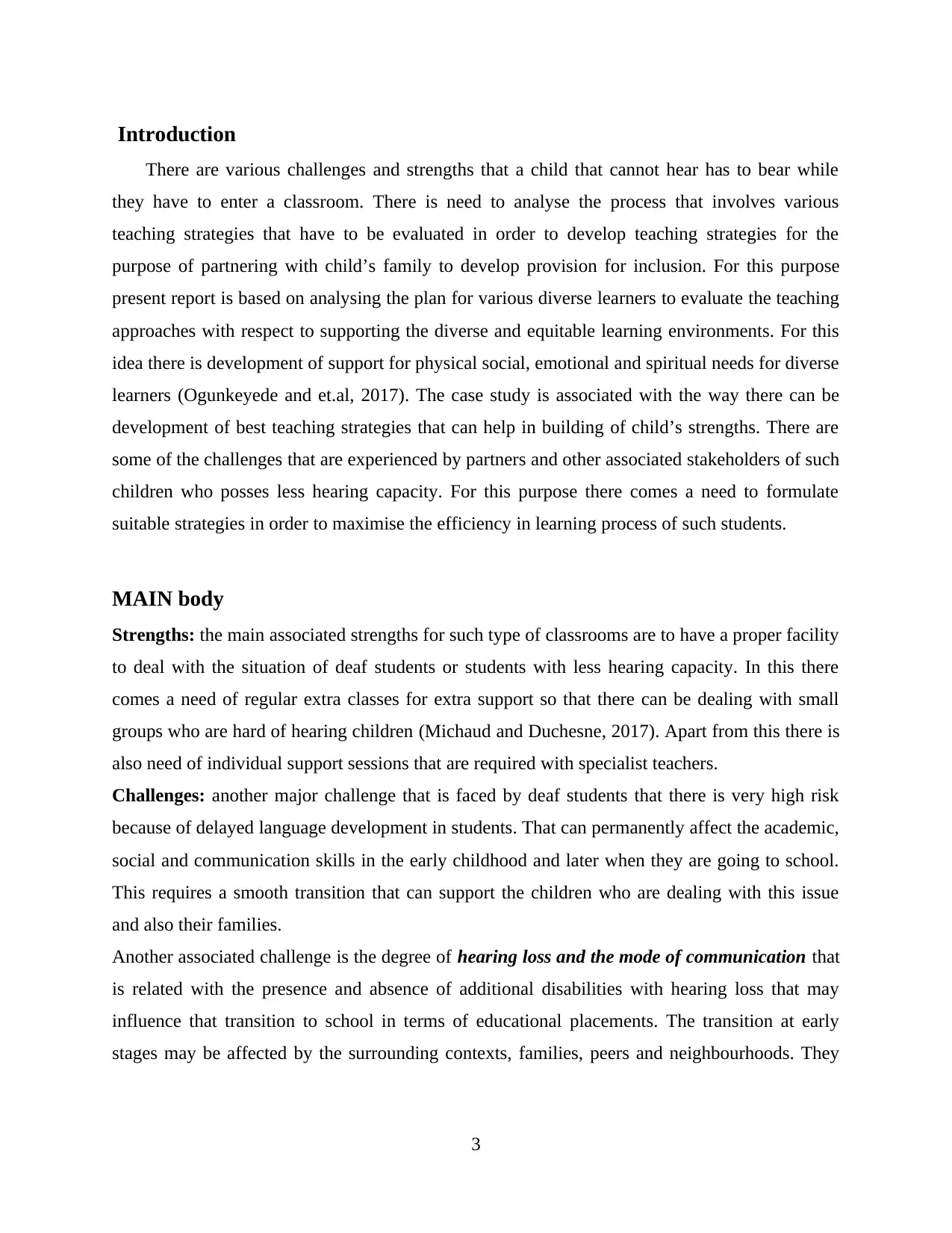
Introduction
There are various challenges and strengths that a child that cannot hear has to bear while
they have to enter a classroom. There is need to analyse the process that involves various
teaching strategies that have to be evaluated in order to develop teaching strategies for the
purpose of partnering with child’s family to develop provision for inclusion. For this purpose
present report is based on analysing the plan for various diverse learners to evaluate the teaching
approaches with respect to supporting the diverse and equitable learning environments. For this
idea there is development of support for physical social, emotional and spiritual needs for diverse
learners (Ogunkeyede and et.al, 2017). The case study is associated with the way there can be
development of best teaching strategies that can help in building of child’s strengths. There are
some of the challenges that are experienced by partners and other associated stakeholders of such
children who posses less hearing capacity. For this purpose there comes a need to formulate
suitable strategies in order to maximise the efficiency in learning process of such students.
MAIN body
Strengths: the main associated strengths for such type of classrooms are to have a proper facility
to deal with the situation of deaf students or students with less hearing capacity. In this there
comes a need of regular extra classes for extra support so that there can be dealing with small
groups who are hard of hearing children (Michaud and Duchesne, 2017). Apart from this there is
also need of individual support sessions that are required with specialist teachers.
Challenges: another major challenge that is faced by deaf students that there is very high risk
because of delayed language development in students. That can permanently affect the academic,
social and communication skills in the early childhood and later when they are going to school.
This requires a smooth transition that can support the children who are dealing with this issue
and also their families.
Another associated challenge is the degree of hearing loss and the mode of communication that
is related with the presence and absence of additional disabilities with hearing loss that may
influence that transition to school in terms of educational placements. The transition at early
stages may be affected by the surrounding contexts, families, peers and neighbourhoods. They
3
There are various challenges and strengths that a child that cannot hear has to bear while
they have to enter a classroom. There is need to analyse the process that involves various
teaching strategies that have to be evaluated in order to develop teaching strategies for the
purpose of partnering with child’s family to develop provision for inclusion. For this purpose
present report is based on analysing the plan for various diverse learners to evaluate the teaching
approaches with respect to supporting the diverse and equitable learning environments. For this
idea there is development of support for physical social, emotional and spiritual needs for diverse
learners (Ogunkeyede and et.al, 2017). The case study is associated with the way there can be
development of best teaching strategies that can help in building of child’s strengths. There are
some of the challenges that are experienced by partners and other associated stakeholders of such
children who posses less hearing capacity. For this purpose there comes a need to formulate
suitable strategies in order to maximise the efficiency in learning process of such students.
MAIN body
Strengths: the main associated strengths for such type of classrooms are to have a proper facility
to deal with the situation of deaf students or students with less hearing capacity. In this there
comes a need of regular extra classes for extra support so that there can be dealing with small
groups who are hard of hearing children (Michaud and Duchesne, 2017). Apart from this there is
also need of individual support sessions that are required with specialist teachers.
Challenges: another major challenge that is faced by deaf students that there is very high risk
because of delayed language development in students. That can permanently affect the academic,
social and communication skills in the early childhood and later when they are going to school.
This requires a smooth transition that can support the children who are dealing with this issue
and also their families.
Another associated challenge is the degree of hearing loss and the mode of communication that
is related with the presence and absence of additional disabilities with hearing loss that may
influence that transition to school in terms of educational placements. The transition at early
stages may be affected by the surrounding contexts, families, peers and neighbourhoods. They
3
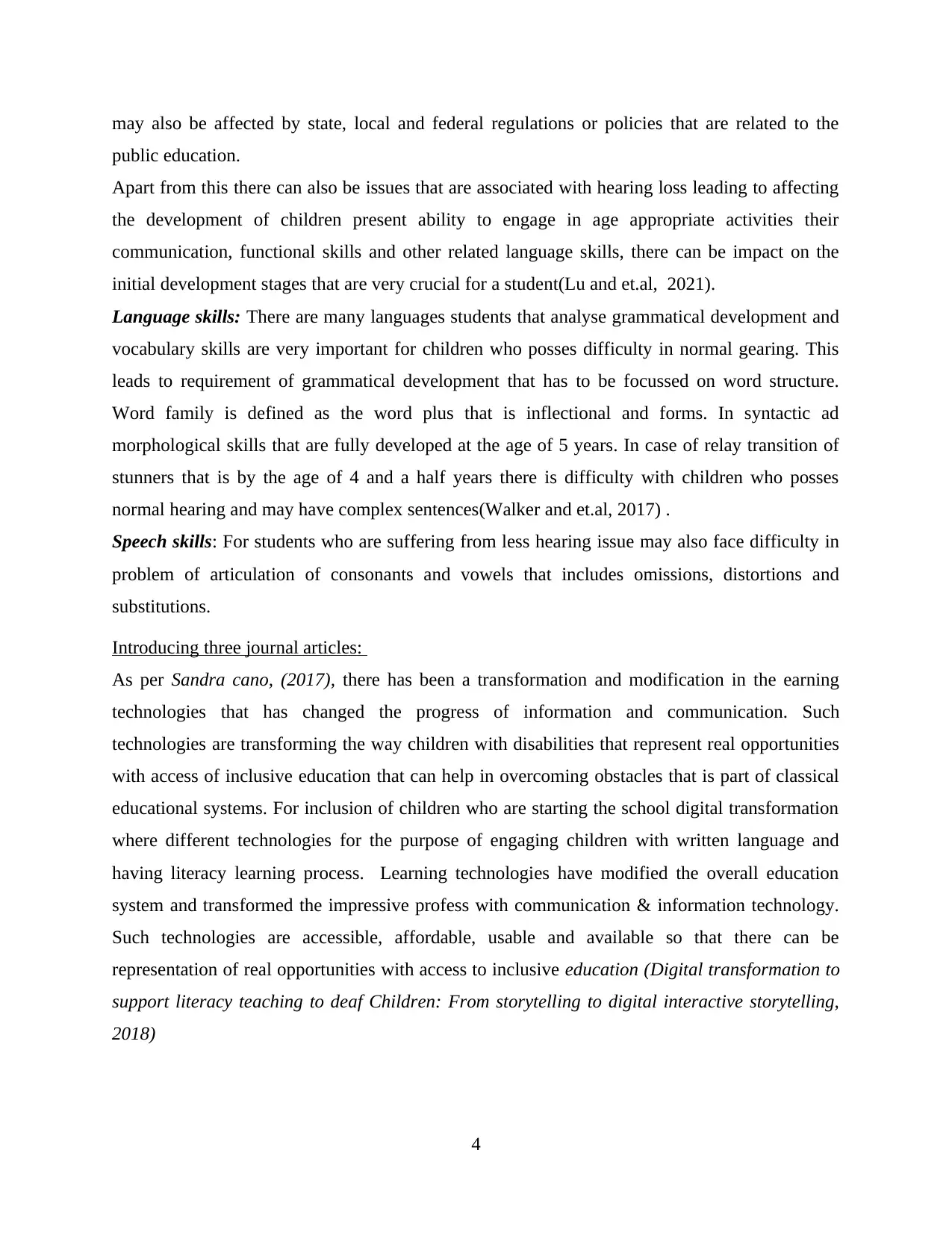
may also be affected by state, local and federal regulations or policies that are related to the
public education.
Apart from this there can also be issues that are associated with hearing loss leading to affecting
the development of children present ability to engage in age appropriate activities their
communication, functional skills and other related language skills, there can be impact on the
initial development stages that are very crucial for a student(Lu and et.al, 2021).
Language skills: There are many languages students that analyse grammatical development and
vocabulary skills are very important for children who posses difficulty in normal gearing. This
leads to requirement of grammatical development that has to be focussed on word structure.
Word family is defined as the word plus that is inflectional and forms. In syntactic ad
morphological skills that are fully developed at the age of 5 years. In case of relay transition of
stunners that is by the age of 4 and a half years there is difficulty with children who posses
normal hearing and may have complex sentences(Walker and et.al, 2017) .
Speech skills: For students who are suffering from less hearing issue may also face difficulty in
problem of articulation of consonants and vowels that includes omissions, distortions and
substitutions.
Introducing three journal articles:
As per Sandra cano, (2017), there has been a transformation and modification in the earning
technologies that has changed the progress of information and communication. Such
technologies are transforming the way children with disabilities that represent real opportunities
with access of inclusive education that can help in overcoming obstacles that is part of classical
educational systems. For inclusion of children who are starting the school digital transformation
where different technologies for the purpose of engaging children with written language and
having literacy learning process. Learning technologies have modified the overall education
system and transformed the impressive profess with communication & information technology.
Such technologies are accessible, affordable, usable and available so that there can be
representation of real opportunities with access to inclusive education (Digital transformation to
support literacy teaching to deaf Children: From storytelling to digital interactive storytelling,
2018)
4
public education.
Apart from this there can also be issues that are associated with hearing loss leading to affecting
the development of children present ability to engage in age appropriate activities their
communication, functional skills and other related language skills, there can be impact on the
initial development stages that are very crucial for a student(Lu and et.al, 2021).
Language skills: There are many languages students that analyse grammatical development and
vocabulary skills are very important for children who posses difficulty in normal gearing. This
leads to requirement of grammatical development that has to be focussed on word structure.
Word family is defined as the word plus that is inflectional and forms. In syntactic ad
morphological skills that are fully developed at the age of 5 years. In case of relay transition of
stunners that is by the age of 4 and a half years there is difficulty with children who posses
normal hearing and may have complex sentences(Walker and et.al, 2017) .
Speech skills: For students who are suffering from less hearing issue may also face difficulty in
problem of articulation of consonants and vowels that includes omissions, distortions and
substitutions.
Introducing three journal articles:
As per Sandra cano, (2017), there has been a transformation and modification in the earning
technologies that has changed the progress of information and communication. Such
technologies are transforming the way children with disabilities that represent real opportunities
with access of inclusive education that can help in overcoming obstacles that is part of classical
educational systems. For inclusion of children who are starting the school digital transformation
where different technologies for the purpose of engaging children with written language and
having literacy learning process. Learning technologies have modified the overall education
system and transformed the impressive profess with communication & information technology.
Such technologies are accessible, affordable, usable and available so that there can be
representation of real opportunities with access to inclusive education (Digital transformation to
support literacy teaching to deaf Children: From storytelling to digital interactive storytelling,
2018)
4
Secure Best Marks with AI Grader
Need help grading? Try our AI Grader for instant feedback on your assignments.
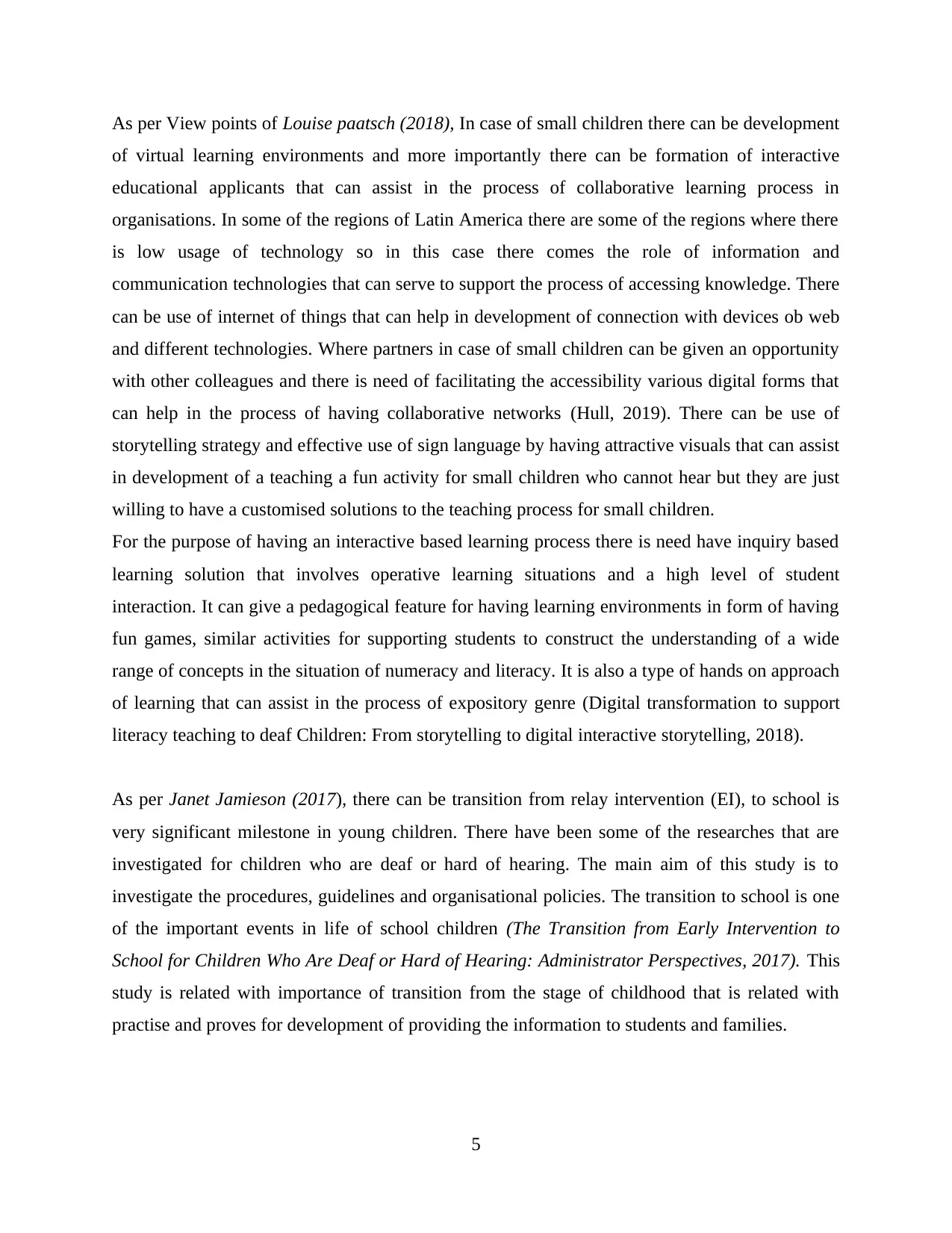
As per View points of Louise paatsch (2018), In case of small children there can be development
of virtual learning environments and more importantly there can be formation of interactive
educational applicants that can assist in the process of collaborative learning process in
organisations. In some of the regions of Latin America there are some of the regions where there
is low usage of technology so in this case there comes the role of information and
communication technologies that can serve to support the process of accessing knowledge. There
can be use of internet of things that can help in development of connection with devices ob web
and different technologies. Where partners in case of small children can be given an opportunity
with other colleagues and there is need of facilitating the accessibility various digital forms that
can help in the process of having collaborative networks (Hull, 2019). There can be use of
storytelling strategy and effective use of sign language by having attractive visuals that can assist
in development of a teaching a fun activity for small children who cannot hear but they are just
willing to have a customised solutions to the teaching process for small children.
For the purpose of having an interactive based learning process there is need have inquiry based
learning solution that involves operative learning situations and a high level of student
interaction. It can give a pedagogical feature for having learning environments in form of having
fun games, similar activities for supporting students to construct the understanding of a wide
range of concepts in the situation of numeracy and literacy. It is also a type of hands on approach
of learning that can assist in the process of expository genre (Digital transformation to support
literacy teaching to deaf Children: From storytelling to digital interactive storytelling, 2018).
As per Janet Jamieson (2017), there can be transition from relay intervention (EI), to school is
very significant milestone in young children. There have been some of the researches that are
investigated for children who are deaf or hard of hearing. The main aim of this study is to
investigate the procedures, guidelines and organisational policies. The transition to school is one
of the important events in life of school children (The Transition from Early Intervention to
School for Children Who Are Deaf or Hard of Hearing: Administrator Perspectives, 2017). This
study is related with importance of transition from the stage of childhood that is related with
practise and proves for development of providing the information to students and families.
5
of virtual learning environments and more importantly there can be formation of interactive
educational applicants that can assist in the process of collaborative learning process in
organisations. In some of the regions of Latin America there are some of the regions where there
is low usage of technology so in this case there comes the role of information and
communication technologies that can serve to support the process of accessing knowledge. There
can be use of internet of things that can help in development of connection with devices ob web
and different technologies. Where partners in case of small children can be given an opportunity
with other colleagues and there is need of facilitating the accessibility various digital forms that
can help in the process of having collaborative networks (Hull, 2019). There can be use of
storytelling strategy and effective use of sign language by having attractive visuals that can assist
in development of a teaching a fun activity for small children who cannot hear but they are just
willing to have a customised solutions to the teaching process for small children.
For the purpose of having an interactive based learning process there is need have inquiry based
learning solution that involves operative learning situations and a high level of student
interaction. It can give a pedagogical feature for having learning environments in form of having
fun games, similar activities for supporting students to construct the understanding of a wide
range of concepts in the situation of numeracy and literacy. It is also a type of hands on approach
of learning that can assist in the process of expository genre (Digital transformation to support
literacy teaching to deaf Children: From storytelling to digital interactive storytelling, 2018).
As per Janet Jamieson (2017), there can be transition from relay intervention (EI), to school is
very significant milestone in young children. There have been some of the researches that are
investigated for children who are deaf or hard of hearing. The main aim of this study is to
investigate the procedures, guidelines and organisational policies. The transition to school is one
of the important events in life of school children (The Transition from Early Intervention to
School for Children Who Are Deaf or Hard of Hearing: Administrator Perspectives, 2017). This
study is related with importance of transition from the stage of childhood that is related with
practise and proves for development of providing the information to students and families.
5
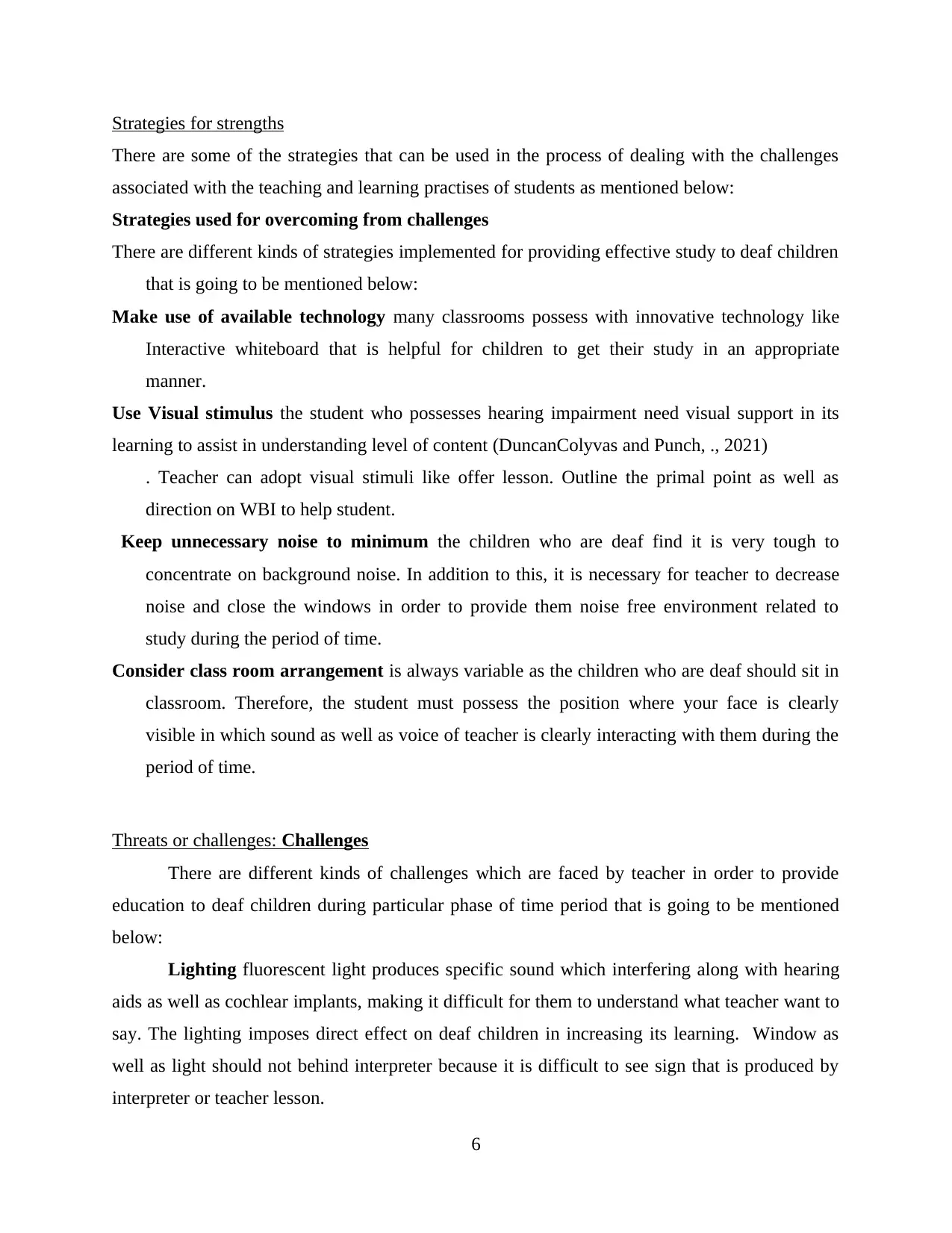
Strategies for strengths
There are some of the strategies that can be used in the process of dealing with the challenges
associated with the teaching and learning practises of students as mentioned below:
Strategies used for overcoming from challenges
There are different kinds of strategies implemented for providing effective study to deaf children
that is going to be mentioned below:
Make use of available technology many classrooms possess with innovative technology like
Interactive whiteboard that is helpful for children to get their study in an appropriate
manner.
Use Visual stimulus the student who possesses hearing impairment need visual support in its
learning to assist in understanding level of content (DuncanColyvas and Punch, ., 2021)
. Teacher can adopt visual stimuli like offer lesson. Outline the primal point as well as
direction on WBI to help student.
Keep unnecessary noise to minimum the children who are deaf find it is very tough to
concentrate on background noise. In addition to this, it is necessary for teacher to decrease
noise and close the windows in order to provide them noise free environment related to
study during the period of time.
Consider class room arrangement is always variable as the children who are deaf should sit in
classroom. Therefore, the student must possess the position where your face is clearly
visible in which sound as well as voice of teacher is clearly interacting with them during the
period of time.
Threats or challenges: Challenges
There are different kinds of challenges which are faced by teacher in order to provide
education to deaf children during particular phase of time period that is going to be mentioned
below:
Lighting fluorescent light produces specific sound which interfering along with hearing
aids as well as cochlear implants, making it difficult for them to understand what teacher want to
say. The lighting imposes direct effect on deaf children in increasing its learning. Window as
well as light should not behind interpreter because it is difficult to see sign that is produced by
interpreter or teacher lesson.
6
There are some of the strategies that can be used in the process of dealing with the challenges
associated with the teaching and learning practises of students as mentioned below:
Strategies used for overcoming from challenges
There are different kinds of strategies implemented for providing effective study to deaf children
that is going to be mentioned below:
Make use of available technology many classrooms possess with innovative technology like
Interactive whiteboard that is helpful for children to get their study in an appropriate
manner.
Use Visual stimulus the student who possesses hearing impairment need visual support in its
learning to assist in understanding level of content (DuncanColyvas and Punch, ., 2021)
. Teacher can adopt visual stimuli like offer lesson. Outline the primal point as well as
direction on WBI to help student.
Keep unnecessary noise to minimum the children who are deaf find it is very tough to
concentrate on background noise. In addition to this, it is necessary for teacher to decrease
noise and close the windows in order to provide them noise free environment related to
study during the period of time.
Consider class room arrangement is always variable as the children who are deaf should sit in
classroom. Therefore, the student must possess the position where your face is clearly
visible in which sound as well as voice of teacher is clearly interacting with them during the
period of time.
Threats or challenges: Challenges
There are different kinds of challenges which are faced by teacher in order to provide
education to deaf children during particular phase of time period that is going to be mentioned
below:
Lighting fluorescent light produces specific sound which interfering along with hearing
aids as well as cochlear implants, making it difficult for them to understand what teacher want to
say. The lighting imposes direct effect on deaf children in increasing its learning. Window as
well as light should not behind interpreter because it is difficult to see sign that is produced by
interpreter or teacher lesson.
6
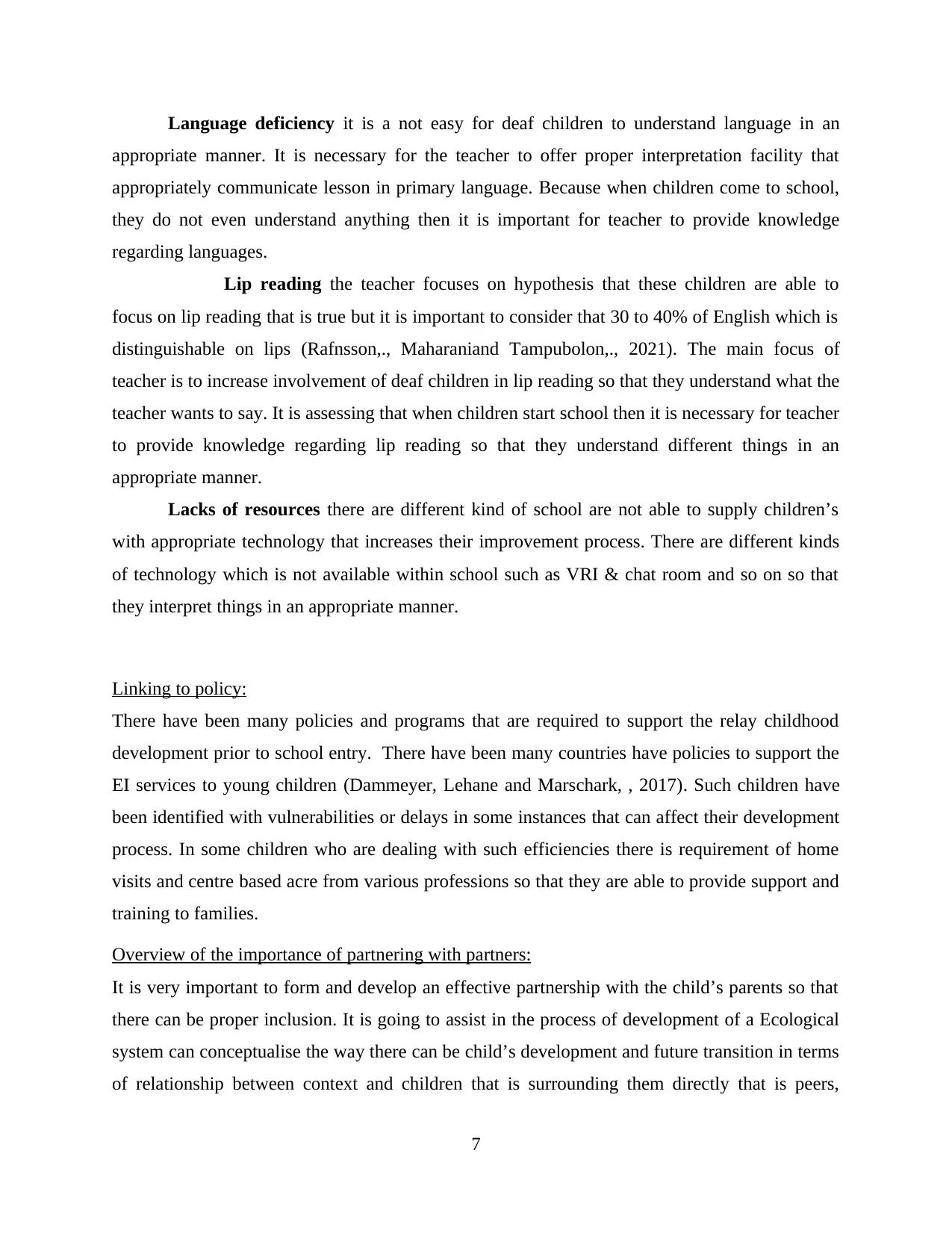
Language deficiency it is a not easy for deaf children to understand language in an
appropriate manner. It is necessary for the teacher to offer proper interpretation facility that
appropriately communicate lesson in primary language. Because when children come to school,
they do not even understand anything then it is important for teacher to provide knowledge
regarding languages.
Lip reading the teacher focuses on hypothesis that these children are able to
focus on lip reading that is true but it is important to consider that 30 to 40% of English which is
distinguishable on lips (Rafnsson,., Maharaniand Tampubolon,., 2021). The main focus of
teacher is to increase involvement of deaf children in lip reading so that they understand what the
teacher wants to say. It is assessing that when children start school then it is necessary for teacher
to provide knowledge regarding lip reading so that they understand different things in an
appropriate manner.
Lacks of resources there are different kind of school are not able to supply children’s
with appropriate technology that increases their improvement process. There are different kinds
of technology which is not available within school such as VRI & chat room and so on so that
they interpret things in an appropriate manner.
Linking to policy:
There have been many policies and programs that are required to support the relay childhood
development prior to school entry. There have been many countries have policies to support the
EI services to young children (Dammeyer, Lehane and Marschark, , 2017). Such children have
been identified with vulnerabilities or delays in some instances that can affect their development
process. In some children who are dealing with such efficiencies there is requirement of home
visits and centre based acre from various professions so that they are able to provide support and
training to families.
Overview of the importance of partnering with partners:
It is very important to form and develop an effective partnership with the child’s parents so that
there can be proper inclusion. It is going to assist in the process of development of a Ecological
system can conceptualise the way there can be child’s development and future transition in terms
of relationship between context and children that is surrounding them directly that is peers,
7
appropriate manner. It is necessary for the teacher to offer proper interpretation facility that
appropriately communicate lesson in primary language. Because when children come to school,
they do not even understand anything then it is important for teacher to provide knowledge
regarding languages.
Lip reading the teacher focuses on hypothesis that these children are able to
focus on lip reading that is true but it is important to consider that 30 to 40% of English which is
distinguishable on lips (Rafnsson,., Maharaniand Tampubolon,., 2021). The main focus of
teacher is to increase involvement of deaf children in lip reading so that they understand what the
teacher wants to say. It is assessing that when children start school then it is necessary for teacher
to provide knowledge regarding lip reading so that they understand different things in an
appropriate manner.
Lacks of resources there are different kind of school are not able to supply children’s
with appropriate technology that increases their improvement process. There are different kinds
of technology which is not available within school such as VRI & chat room and so on so that
they interpret things in an appropriate manner.
Linking to policy:
There have been many policies and programs that are required to support the relay childhood
development prior to school entry. There have been many countries have policies to support the
EI services to young children (Dammeyer, Lehane and Marschark, , 2017). Such children have
been identified with vulnerabilities or delays in some instances that can affect their development
process. In some children who are dealing with such efficiencies there is requirement of home
visits and centre based acre from various professions so that they are able to provide support and
training to families.
Overview of the importance of partnering with partners:
It is very important to form and develop an effective partnership with the child’s parents so that
there can be proper inclusion. It is going to assist in the process of development of a Ecological
system can conceptualise the way there can be child’s development and future transition in terms
of relationship between context and children that is surrounding them directly that is peers,
7
Paraphrase This Document
Need a fresh take? Get an instant paraphrase of this document with our AI Paraphraser
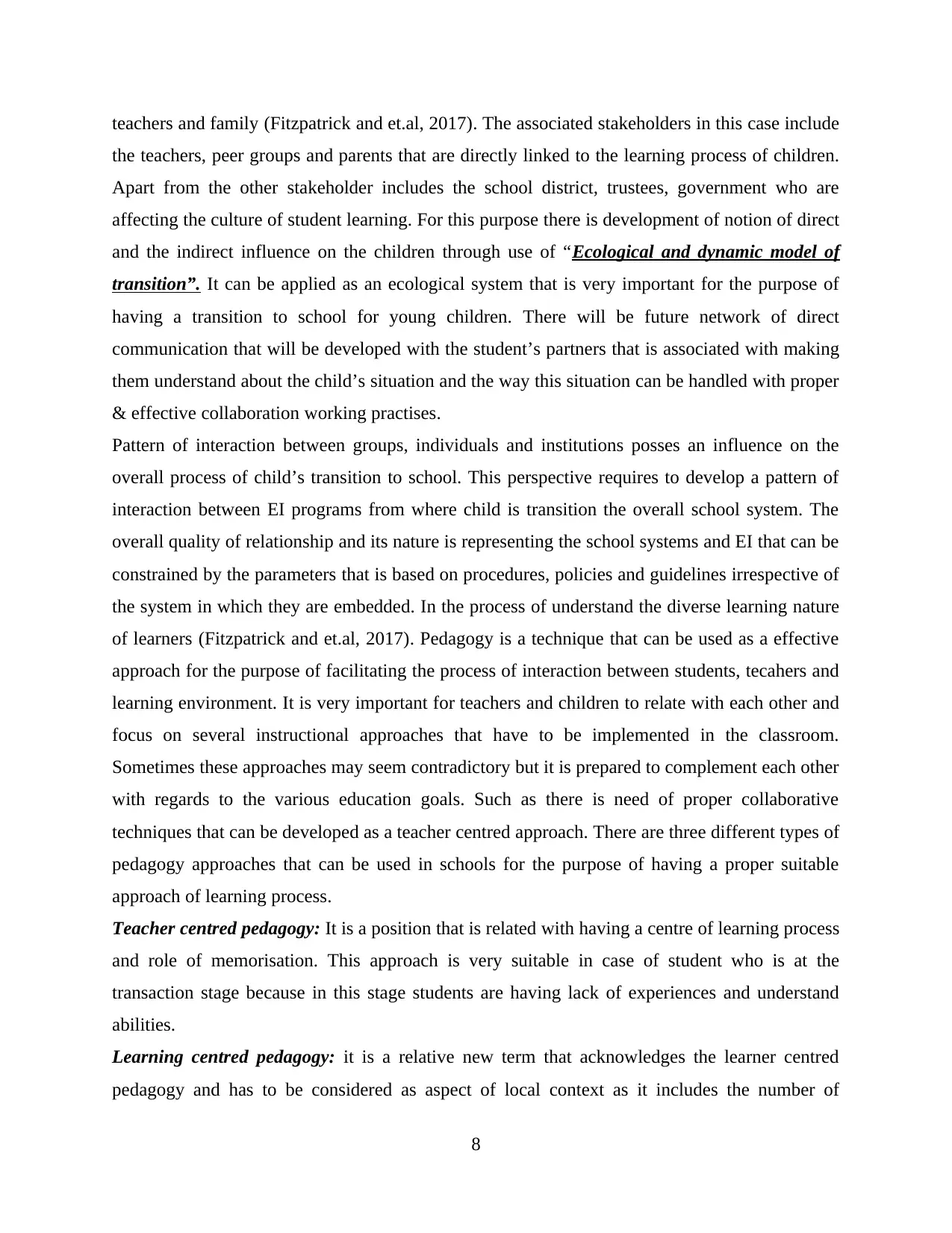
teachers and family (Fitzpatrick and et.al, 2017). The associated stakeholders in this case include
the teachers, peer groups and parents that are directly linked to the learning process of children.
Apart from the other stakeholder includes the school district, trustees, government who are
affecting the culture of student learning. For this purpose there is development of notion of direct
and the indirect influence on the children through use of “Ecological and dynamic model of
transition”. It can be applied as an ecological system that is very important for the purpose of
having a transition to school for young children. There will be future network of direct
communication that will be developed with the student’s partners that is associated with making
them understand about the child’s situation and the way this situation can be handled with proper
& effective collaboration working practises.
Pattern of interaction between groups, individuals and institutions posses an influence on the
overall process of child’s transition to school. This perspective requires to develop a pattern of
interaction between EI programs from where child is transition the overall school system. The
overall quality of relationship and its nature is representing the school systems and EI that can be
constrained by the parameters that is based on procedures, policies and guidelines irrespective of
the system in which they are embedded. In the process of understand the diverse learning nature
of learners (Fitzpatrick and et.al, 2017). Pedagogy is a technique that can be used as a effective
approach for the purpose of facilitating the process of interaction between students, tecahers and
learning environment. It is very important for teachers and children to relate with each other and
focus on several instructional approaches that have to be implemented in the classroom.
Sometimes these approaches may seem contradictory but it is prepared to complement each other
with regards to the various education goals. Such as there is need of proper collaborative
techniques that can be developed as a teacher centred approach. There are three different types of
pedagogy approaches that can be used in schools for the purpose of having a proper suitable
approach of learning process.
Teacher centred pedagogy: It is a position that is related with having a centre of learning process
and role of memorisation. This approach is very suitable in case of student who is at the
transaction stage because in this stage students are having lack of experiences and understand
abilities.
Learning centred pedagogy: it is a relative new term that acknowledges the learner centred
pedagogy and has to be considered as aspect of local context as it includes the number of
8
the teachers, peer groups and parents that are directly linked to the learning process of children.
Apart from the other stakeholder includes the school district, trustees, government who are
affecting the culture of student learning. For this purpose there is development of notion of direct
and the indirect influence on the children through use of “Ecological and dynamic model of
transition”. It can be applied as an ecological system that is very important for the purpose of
having a transition to school for young children. There will be future network of direct
communication that will be developed with the student’s partners that is associated with making
them understand about the child’s situation and the way this situation can be handled with proper
& effective collaboration working practises.
Pattern of interaction between groups, individuals and institutions posses an influence on the
overall process of child’s transition to school. This perspective requires to develop a pattern of
interaction between EI programs from where child is transition the overall school system. The
overall quality of relationship and its nature is representing the school systems and EI that can be
constrained by the parameters that is based on procedures, policies and guidelines irrespective of
the system in which they are embedded. In the process of understand the diverse learning nature
of learners (Fitzpatrick and et.al, 2017). Pedagogy is a technique that can be used as a effective
approach for the purpose of facilitating the process of interaction between students, tecahers and
learning environment. It is very important for teachers and children to relate with each other and
focus on several instructional approaches that have to be implemented in the classroom.
Sometimes these approaches may seem contradictory but it is prepared to complement each other
with regards to the various education goals. Such as there is need of proper collaborative
techniques that can be developed as a teacher centred approach. There are three different types of
pedagogy approaches that can be used in schools for the purpose of having a proper suitable
approach of learning process.
Teacher centred pedagogy: It is a position that is related with having a centre of learning process
and role of memorisation. This approach is very suitable in case of student who is at the
transaction stage because in this stage students are having lack of experiences and understand
abilities.
Learning centred pedagogy: it is a relative new term that acknowledges the learner centred
pedagogy and has to be considered as aspect of local context as it includes the number of
8
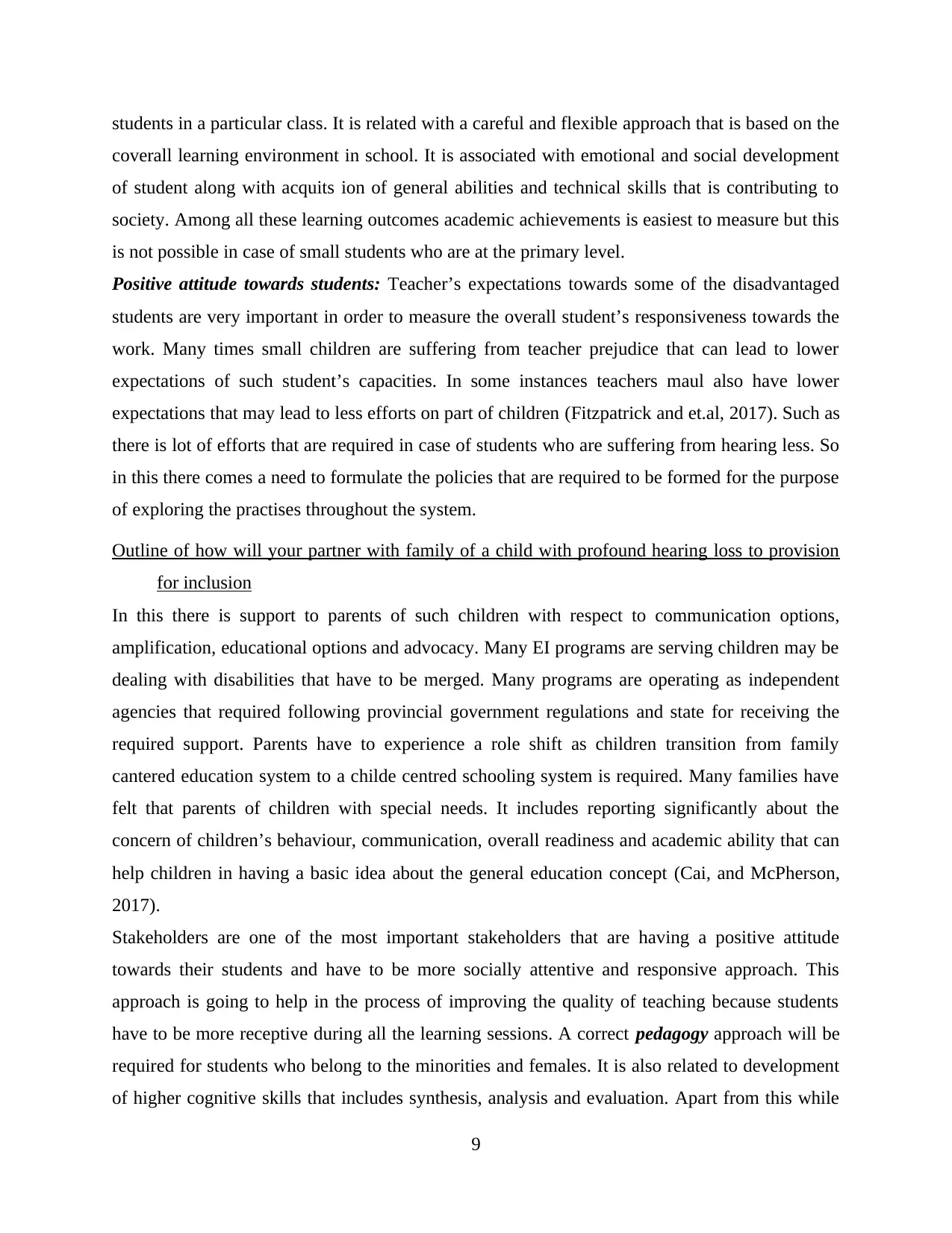
students in a particular class. It is related with a careful and flexible approach that is based on the
coverall learning environment in school. It is associated with emotional and social development
of student along with acquits ion of general abilities and technical skills that is contributing to
society. Among all these learning outcomes academic achievements is easiest to measure but this
is not possible in case of small students who are at the primary level.
Positive attitude towards students: Teacher’s expectations towards some of the disadvantaged
students are very important in order to measure the overall student’s responsiveness towards the
work. Many times small children are suffering from teacher prejudice that can lead to lower
expectations of such student’s capacities. In some instances teachers maul also have lower
expectations that may lead to less efforts on part of children (Fitzpatrick and et.al, 2017). Such as
there is lot of efforts that are required in case of students who are suffering from hearing less. So
in this there comes a need to formulate the policies that are required to be formed for the purpose
of exploring the practises throughout the system.
Outline of how will your partner with family of a child with profound hearing loss to provision
for inclusion
In this there is support to parents of such children with respect to communication options,
amplification, educational options and advocacy. Many EI programs are serving children may be
dealing with disabilities that have to be merged. Many programs are operating as independent
agencies that required following provincial government regulations and state for receiving the
required support. Parents have to experience a role shift as children transition from family
cantered education system to a childe centred schooling system is required. Many families have
felt that parents of children with special needs. It includes reporting significantly about the
concern of children’s behaviour, communication, overall readiness and academic ability that can
help children in having a basic idea about the general education concept (Cai, and McPherson,
2017).
Stakeholders are one of the most important stakeholders that are having a positive attitude
towards their students and have to be more socially attentive and responsive approach. This
approach is going to help in the process of improving the quality of teaching because students
have to be more receptive during all the learning sessions. A correct pedagogy approach will be
required for students who belong to the minorities and females. It is also related to development
of higher cognitive skills that includes synthesis, analysis and evaluation. Apart from this while
9
coverall learning environment in school. It is associated with emotional and social development
of student along with acquits ion of general abilities and technical skills that is contributing to
society. Among all these learning outcomes academic achievements is easiest to measure but this
is not possible in case of small students who are at the primary level.
Positive attitude towards students: Teacher’s expectations towards some of the disadvantaged
students are very important in order to measure the overall student’s responsiveness towards the
work. Many times small children are suffering from teacher prejudice that can lead to lower
expectations of such student’s capacities. In some instances teachers maul also have lower
expectations that may lead to less efforts on part of children (Fitzpatrick and et.al, 2017). Such as
there is lot of efforts that are required in case of students who are suffering from hearing less. So
in this there comes a need to formulate the policies that are required to be formed for the purpose
of exploring the practises throughout the system.
Outline of how will your partner with family of a child with profound hearing loss to provision
for inclusion
In this there is support to parents of such children with respect to communication options,
amplification, educational options and advocacy. Many EI programs are serving children may be
dealing with disabilities that have to be merged. Many programs are operating as independent
agencies that required following provincial government regulations and state for receiving the
required support. Parents have to experience a role shift as children transition from family
cantered education system to a childe centred schooling system is required. Many families have
felt that parents of children with special needs. It includes reporting significantly about the
concern of children’s behaviour, communication, overall readiness and academic ability that can
help children in having a basic idea about the general education concept (Cai, and McPherson,
2017).
Stakeholders are one of the most important stakeholders that are having a positive attitude
towards their students and have to be more socially attentive and responsive approach. This
approach is going to help in the process of improving the quality of teaching because students
have to be more receptive during all the learning sessions. A correct pedagogy approach will be
required for students who belong to the minorities and females. It is also related to development
of higher cognitive skills that includes synthesis, analysis and evaluation. Apart from this while
9
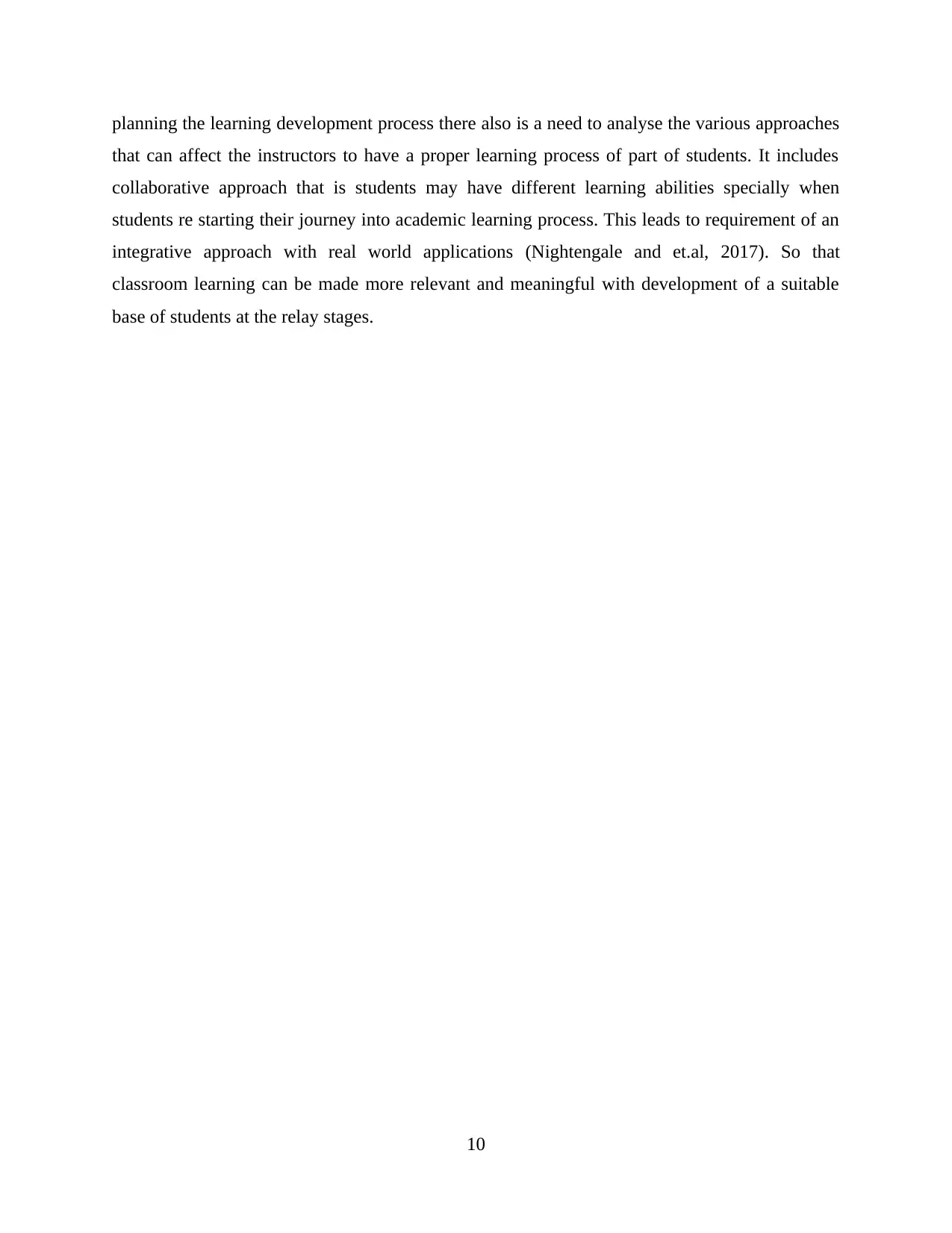
planning the learning development process there also is a need to analyse the various approaches
that can affect the instructors to have a proper learning process of part of students. It includes
collaborative approach that is students may have different learning abilities specially when
students re starting their journey into academic learning process. This leads to requirement of an
integrative approach with real world applications (Nightengale and et.al, 2017). So that
classroom learning can be made more relevant and meaningful with development of a suitable
base of students at the relay stages.
10
that can affect the instructors to have a proper learning process of part of students. It includes
collaborative approach that is students may have different learning abilities specially when
students re starting their journey into academic learning process. This leads to requirement of an
integrative approach with real world applications (Nightengale and et.al, 2017). So that
classroom learning can be made more relevant and meaningful with development of a suitable
base of students at the relay stages.
10
Secure Best Marks with AI Grader
Need help grading? Try our AI Grader for instant feedback on your assignments.
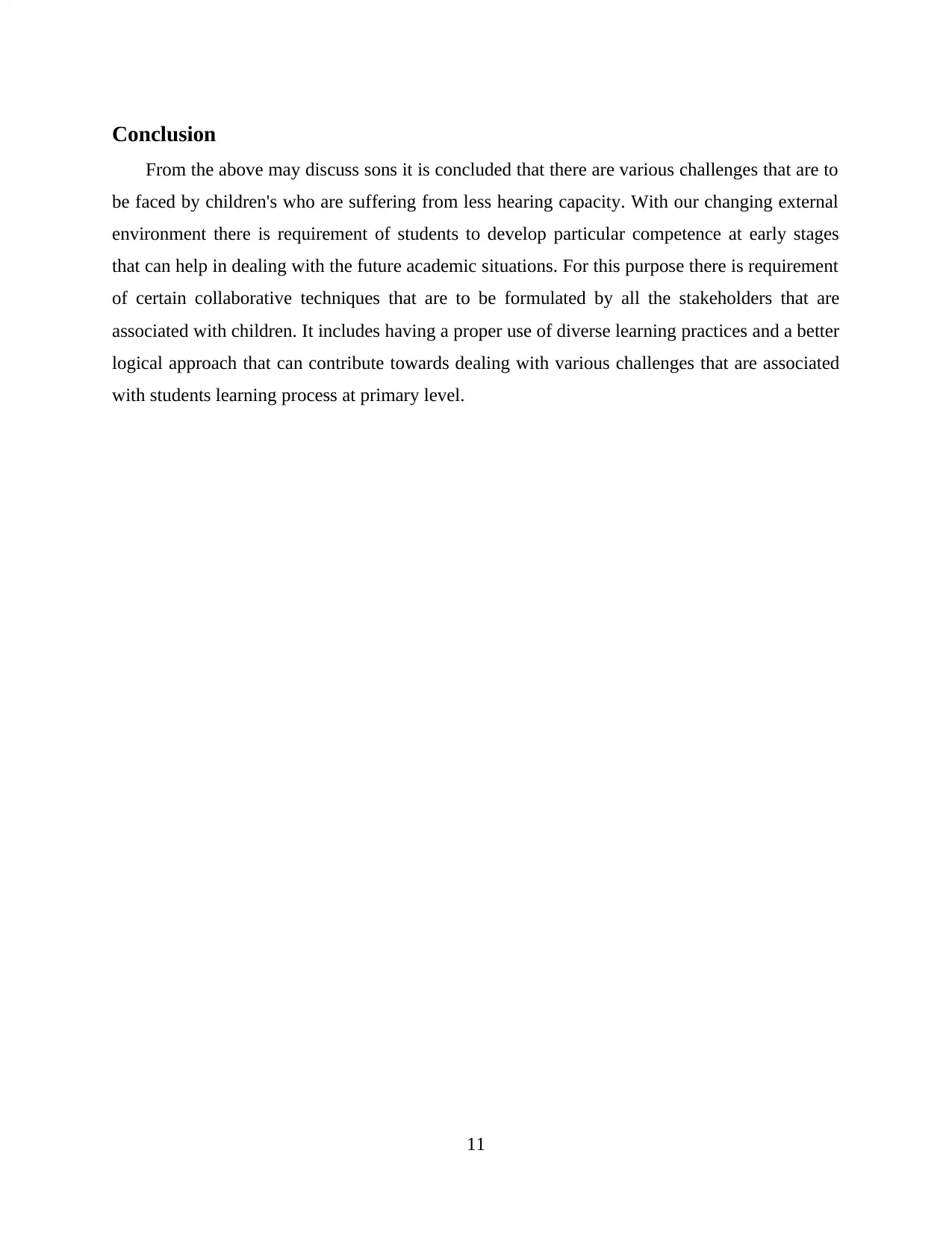
Conclusion
From the above may discuss sons it is concluded that there are various challenges that are to
be faced by children's who are suffering from less hearing capacity. With our changing external
environment there is requirement of students to develop particular competence at early stages
that can help in dealing with the future academic situations. For this purpose there is requirement
of certain collaborative techniques that are to be formulated by all the stakeholders that are
associated with children. It includes having a proper use of diverse learning practices and a better
logical approach that can contribute towards dealing with various challenges that are associated
with students learning process at primary level.
11
From the above may discuss sons it is concluded that there are various challenges that are to
be faced by children's who are suffering from less hearing capacity. With our changing external
environment there is requirement of students to develop particular competence at early stages
that can help in dealing with the future academic situations. For this purpose there is requirement
of certain collaborative techniques that are to be formulated by all the stakeholders that are
associated with children. It includes having a proper use of diverse learning practices and a better
logical approach that can contribute towards dealing with various challenges that are associated
with students learning process at primary level.
11
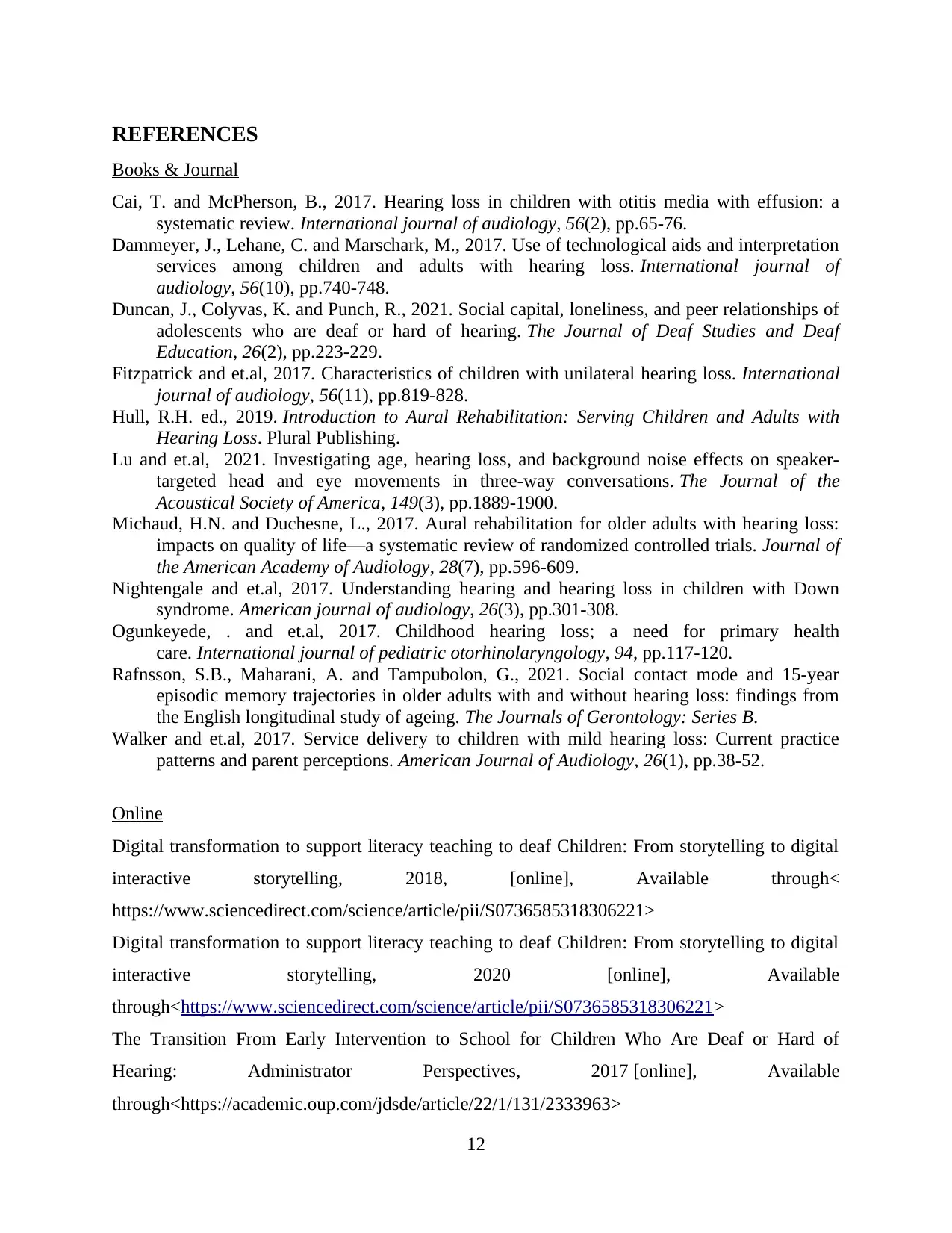
REFERENCES
Books & Journal
Cai, T. and McPherson, B., 2017. Hearing loss in children with otitis media with effusion: a
systematic review. International journal of audiology, 56(2), pp.65-76.
Dammeyer, J., Lehane, C. and Marschark, M., 2017. Use of technological aids and interpretation
services among children and adults with hearing loss. International journal of
audiology, 56(10), pp.740-748.
Duncan, J., Colyvas, K. and Punch, R., 2021. Social capital, loneliness, and peer relationships of
adolescents who are deaf or hard of hearing. The Journal of Deaf Studies and Deaf
Education, 26(2), pp.223-229.
Fitzpatrick and et.al, 2017. Characteristics of children with unilateral hearing loss. International
journal of audiology, 56(11), pp.819-828.
Hull, R.H. ed., 2019. Introduction to Aural Rehabilitation: Serving Children and Adults with
Hearing Loss. Plural Publishing.
Lu and et.al, 2021. Investigating age, hearing loss, and background noise effects on speaker-
targeted head and eye movements in three-way conversations. The Journal of the
Acoustical Society of America, 149(3), pp.1889-1900.
Michaud, H.N. and Duchesne, L., 2017. Aural rehabilitation for older adults with hearing loss:
impacts on quality of life—a systematic review of randomized controlled trials. Journal of
the American Academy of Audiology, 28(7), pp.596-609.
Nightengale and et.al, 2017. Understanding hearing and hearing loss in children with Down
syndrome. American journal of audiology, 26(3), pp.301-308.
Ogunkeyede, . and et.al, 2017. Childhood hearing loss; a need for primary health
care. International journal of pediatric otorhinolaryngology, 94, pp.117-120.
Rafnsson, S.B., Maharani, A. and Tampubolon, G., 2021. Social contact mode and 15-year
episodic memory trajectories in older adults with and without hearing loss: findings from
the English longitudinal study of ageing. The Journals of Gerontology: Series B.
Walker and et.al, 2017. Service delivery to children with mild hearing loss: Current practice
patterns and parent perceptions. American Journal of Audiology, 26(1), pp.38-52.
Online
Digital transformation to support literacy teaching to deaf Children: From storytelling to digital
interactive storytelling, 2018, [online], Available through<
https://www.sciencedirect.com/science/article/pii/S0736585318306221>
Digital transformation to support literacy teaching to deaf Children: From storytelling to digital
interactive storytelling, 2020 [online], Available
through<https://www.sciencedirect.com/science/article/pii/S0736585318306221>
The Transition From Early Intervention to School for Children Who Are Deaf or Hard of
Hearing: Administrator Perspectives, 2017 [online], Available
through<https://academic.oup.com/jdsde/article/22/1/131/2333963>
12
Books & Journal
Cai, T. and McPherson, B., 2017. Hearing loss in children with otitis media with effusion: a
systematic review. International journal of audiology, 56(2), pp.65-76.
Dammeyer, J., Lehane, C. and Marschark, M., 2017. Use of technological aids and interpretation
services among children and adults with hearing loss. International journal of
audiology, 56(10), pp.740-748.
Duncan, J., Colyvas, K. and Punch, R., 2021. Social capital, loneliness, and peer relationships of
adolescents who are deaf or hard of hearing. The Journal of Deaf Studies and Deaf
Education, 26(2), pp.223-229.
Fitzpatrick and et.al, 2017. Characteristics of children with unilateral hearing loss. International
journal of audiology, 56(11), pp.819-828.
Hull, R.H. ed., 2019. Introduction to Aural Rehabilitation: Serving Children and Adults with
Hearing Loss. Plural Publishing.
Lu and et.al, 2021. Investigating age, hearing loss, and background noise effects on speaker-
targeted head and eye movements in three-way conversations. The Journal of the
Acoustical Society of America, 149(3), pp.1889-1900.
Michaud, H.N. and Duchesne, L., 2017. Aural rehabilitation for older adults with hearing loss:
impacts on quality of life—a systematic review of randomized controlled trials. Journal of
the American Academy of Audiology, 28(7), pp.596-609.
Nightengale and et.al, 2017. Understanding hearing and hearing loss in children with Down
syndrome. American journal of audiology, 26(3), pp.301-308.
Ogunkeyede, . and et.al, 2017. Childhood hearing loss; a need for primary health
care. International journal of pediatric otorhinolaryngology, 94, pp.117-120.
Rafnsson, S.B., Maharani, A. and Tampubolon, G., 2021. Social contact mode and 15-year
episodic memory trajectories in older adults with and without hearing loss: findings from
the English longitudinal study of ageing. The Journals of Gerontology: Series B.
Walker and et.al, 2017. Service delivery to children with mild hearing loss: Current practice
patterns and parent perceptions. American Journal of Audiology, 26(1), pp.38-52.
Online
Digital transformation to support literacy teaching to deaf Children: From storytelling to digital
interactive storytelling, 2018, [online], Available through<
https://www.sciencedirect.com/science/article/pii/S0736585318306221>
Digital transformation to support literacy teaching to deaf Children: From storytelling to digital
interactive storytelling, 2020 [online], Available
through<https://www.sciencedirect.com/science/article/pii/S0736585318306221>
The Transition From Early Intervention to School for Children Who Are Deaf or Hard of
Hearing: Administrator Perspectives, 2017 [online], Available
through<https://academic.oup.com/jdsde/article/22/1/131/2333963>
12
1 out of 12
Related Documents
Your All-in-One AI-Powered Toolkit for Academic Success.
+13062052269
info@desklib.com
Available 24*7 on WhatsApp / Email
![[object Object]](/_next/static/media/star-bottom.7253800d.svg)
Unlock your academic potential
© 2024 | Zucol Services PVT LTD | All rights reserved.




